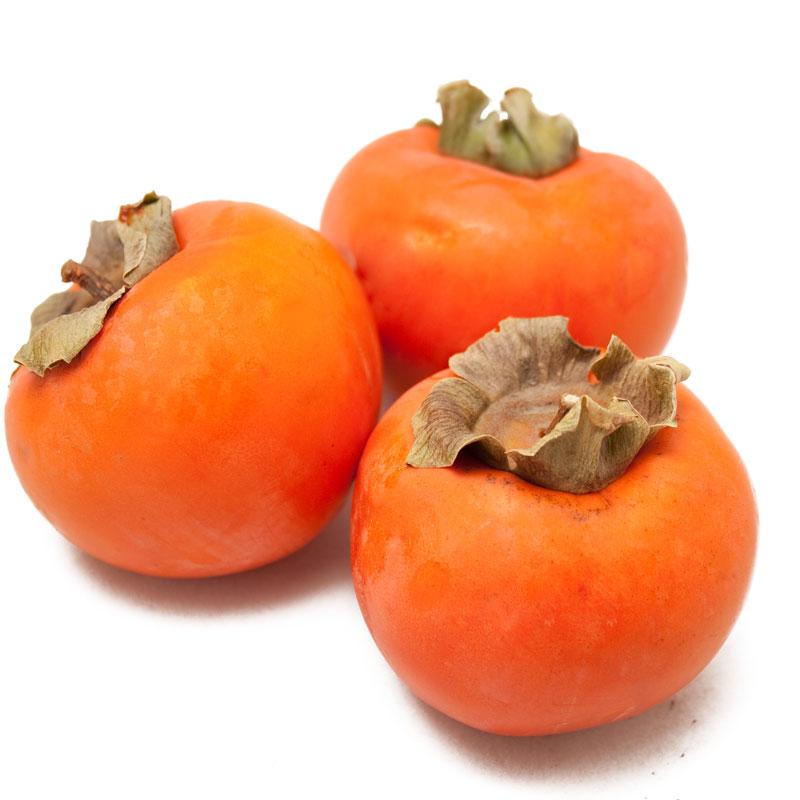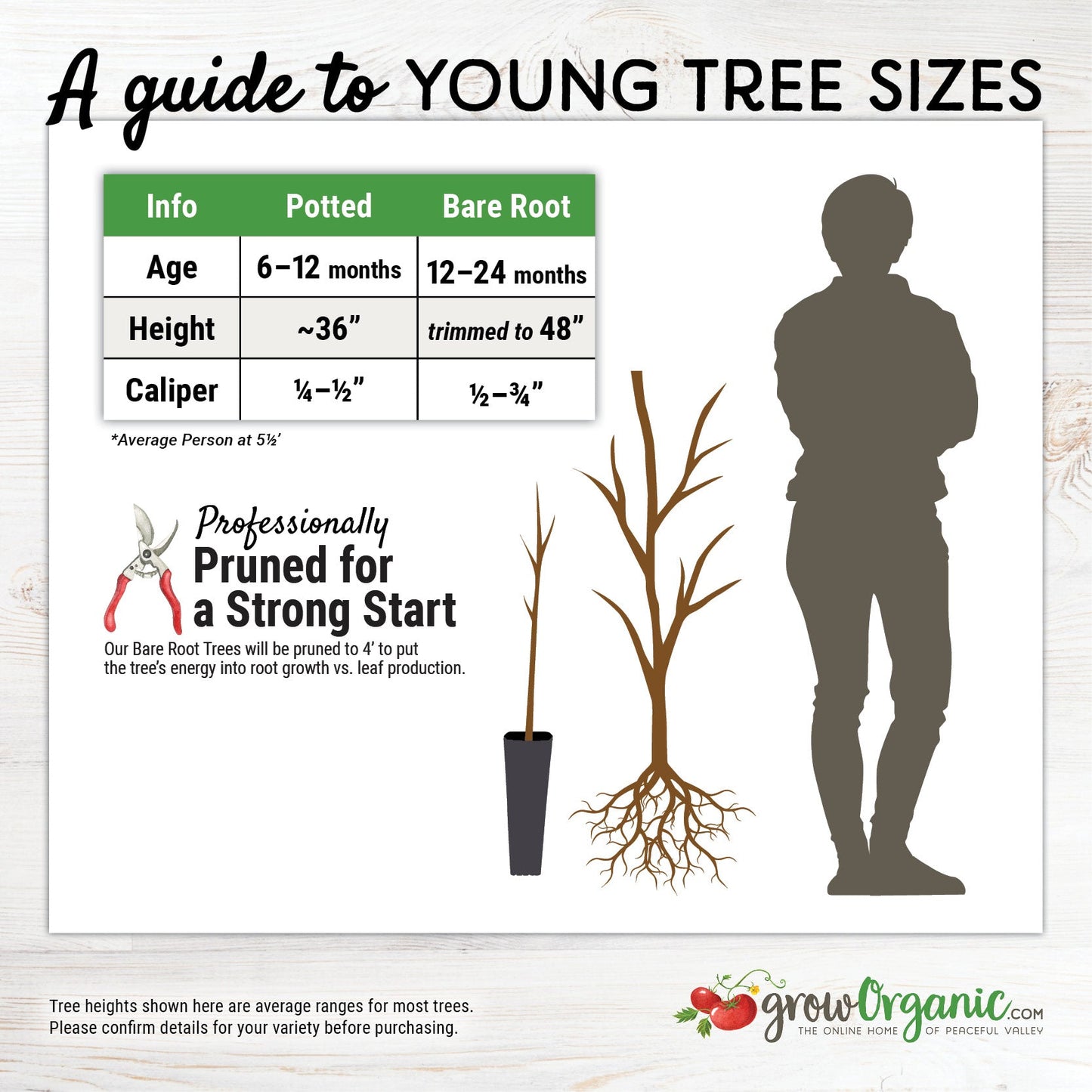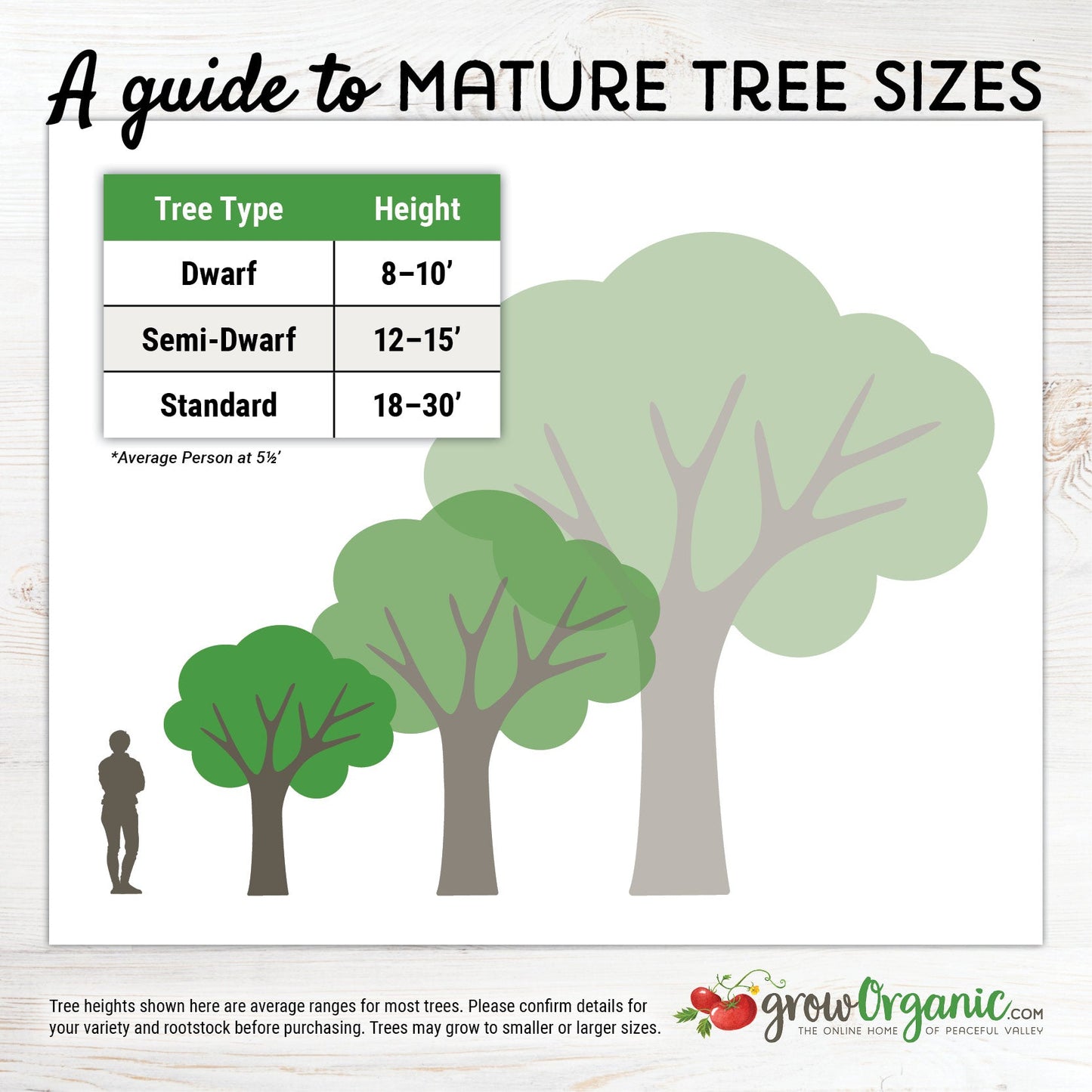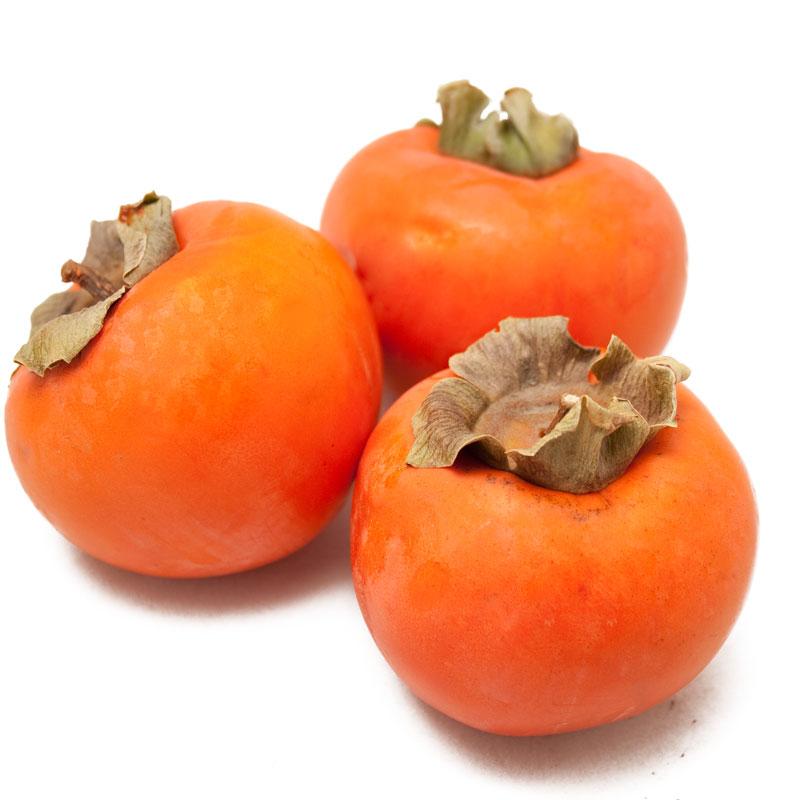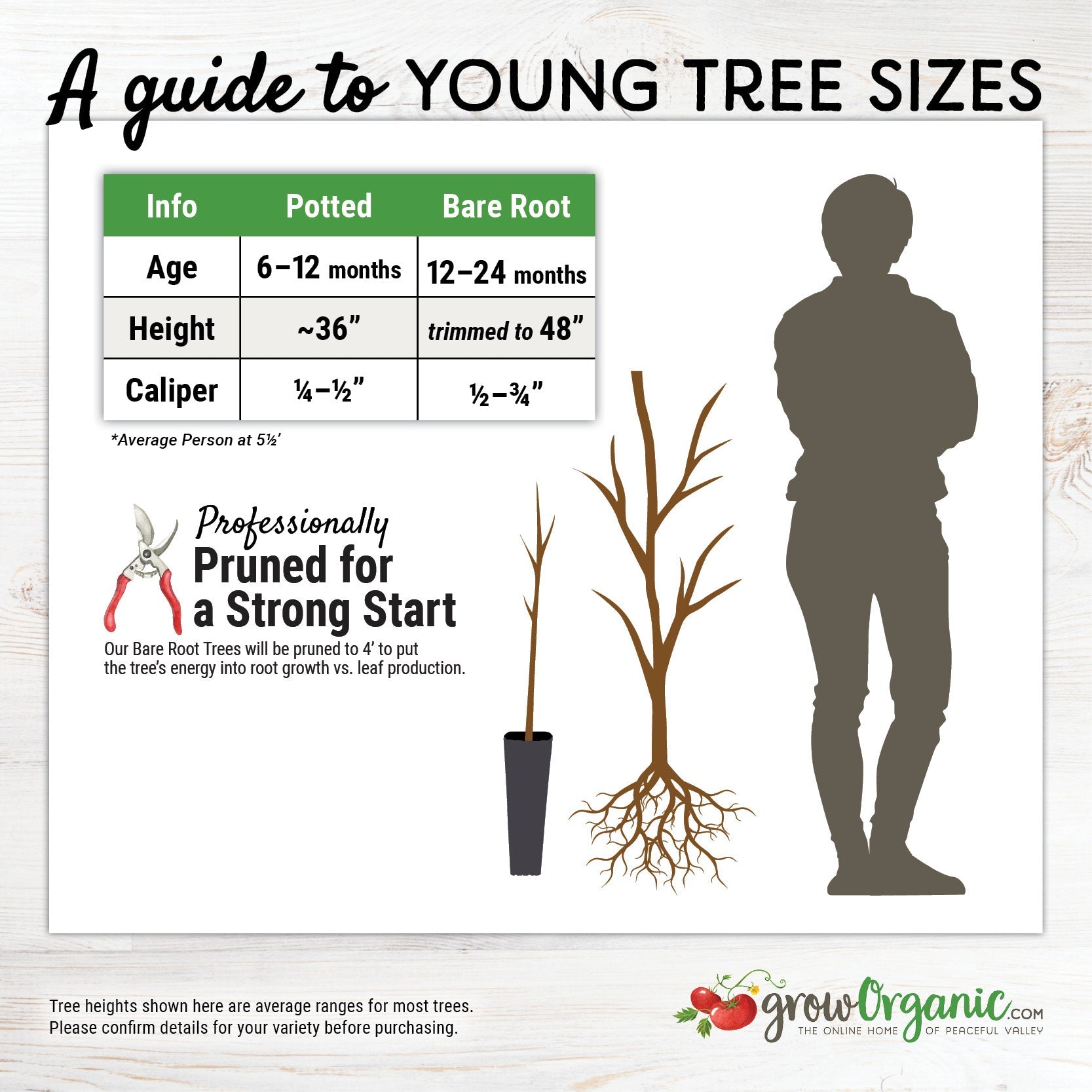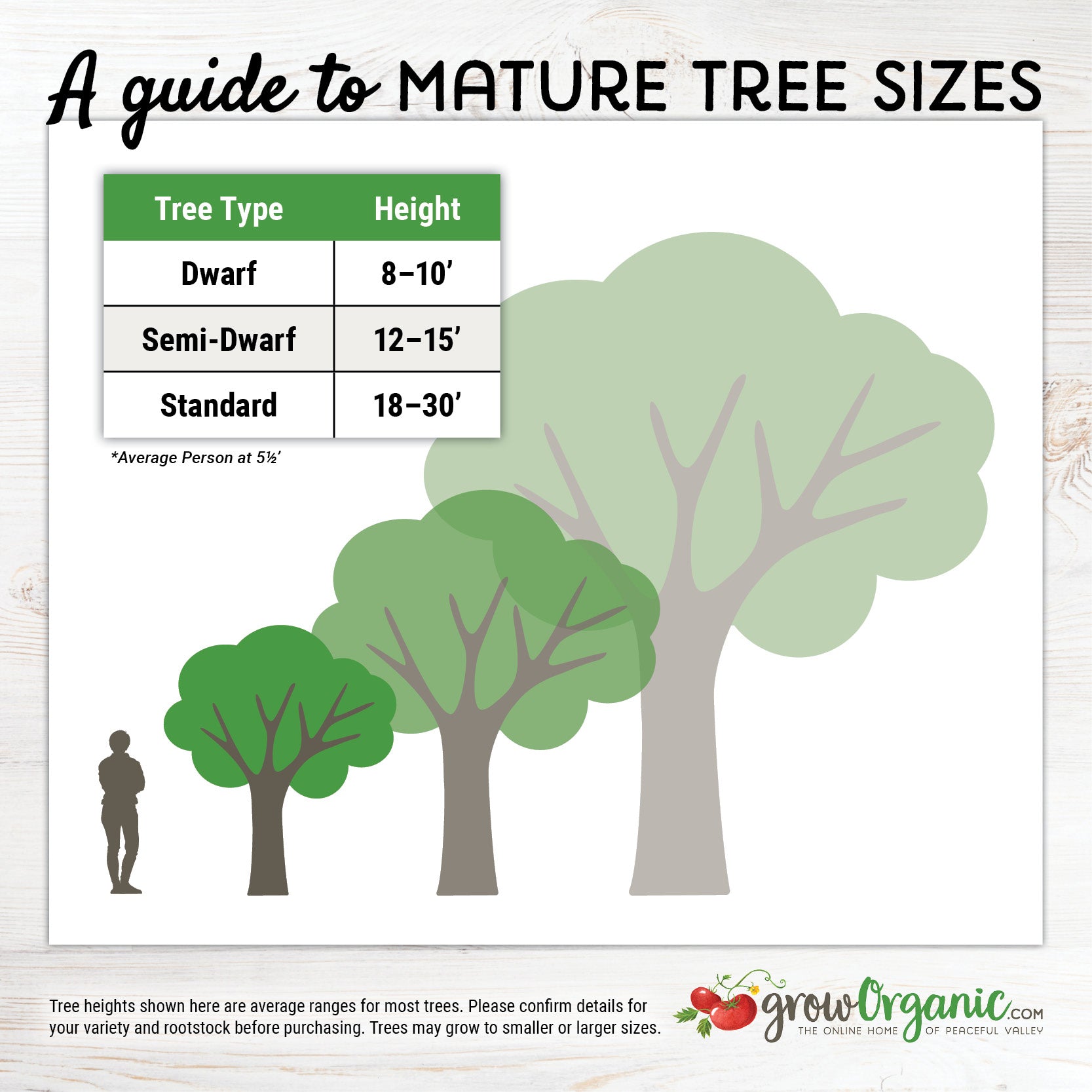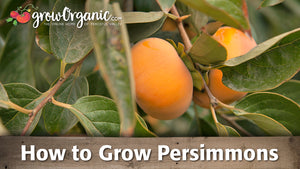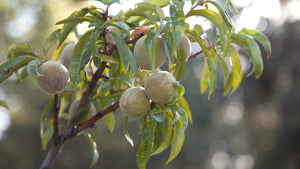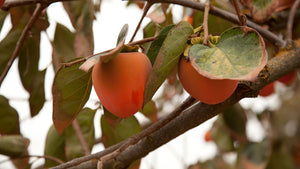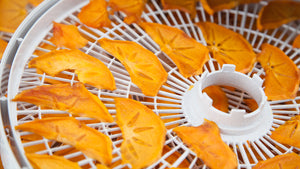Item Number: FT232
Jiro', Fuyu Persimmon, Tree
Jiro', Fuyu Persimmon, Tree
Best for Eating Fresh
Standard on D. Lotus rootstock.
Growing Zones: USDA Plant hardiness zones 7 to 10.
Chill Requirements: Typically, they don't require specific chill hours for fruiting.
Bloom Time: Late Spring
Approximate Harvesting Dates: Late Fall
Looks: The fruits are squat, tomato-shaped with vibrant orange hues when ripe.
Personality: Known for their sweet, non-astringent taste and adaptability to various climates.
Facts of Note: Enjoy Fuyu Persimmons fresh, as they offer rich vitamins A and C, dietary fiber, and antioxidants for a nutritious boost.
Pollinator: Generally, Fuyu Persimmons are self-fruitful and don't require a separate pollinator for fruiting.
Soil Temperatures: 60°F to 80°F.
Planting Depths: Plant young trees at the same depth as they were growing in the nursery container.
Germination Periods: Typically grown from grafted trees rather than seeds. 30 to 90 days
Height at Maturity:15 to 20 feet (4.6 to 6.1 meters).
Days to Maturity: Around 2 to 3 years for the tree to start bearing fruit, with full production in 5 to 7 years.
Sun/Shade: Fuyu Persimmons prefer full sun for optimal fruit production.
Spacing After Thinning: Proper spacing of fruits is crucial for larger, healthier fruit development, usually about 4 to 6 inches apart.
Cultivating Fuyu persimmons, a delightful variety of Diospyros kaki, is a rewarding endeavor that brings forth vibrant and sweet fruit. Known for their distinct characteristics, Fuyu persimmons are a popular choice among orchard enthusiasts. Learn How to grow Fuyu persimmons , know the plant’s traits, and care for a good harvest with this guide.
Fuyu persimmons, renowned for their sweet and crisp fruit, require careful attention to water and nutrient management to thrive. Before planting, check zone maps to make sure the plants can handle the winter temperatures in your area.
Once established, these trees develop extensive feeder root systems, absorbing water and minerals efficiently. Mature trees benefit from regular watering, especially during hot summers, to support fruit production and prevent stress. Fuyu persimmon trees need proper soil moisture and nutrients to grow well and produce tasty fruit. Taking care of these factors is important for growers. Good soil Moisture and nutrients help the trees thrive. This results in a bountiful harvest of delicious fruit.
Fruit tree Characteristics: Fuyu persimmons boast squat, tomato-shaped fruits that display vibrant orange hues when fully ripe. They are easily identifiable by their deep orange coloration, making them a striking addition to any orchard or garden.
Taste Profile: Renowned for their delectable taste, Fuyu persimmons are celebrated for their sweet, non-astringent flavor. Their appeal lies in their pleasant taste, making them a great source of enjoyment when consumed fresh.
Adaptability and Growing Zones: Fuyu persimmons thrive in a variety of climates, especially in USDA hardiness zones 7 to 10. They appeal to orchards across the United States because of their adaptability to various environmental conditions. A well draining soil type is preferred to avoid the tree roots from root rot.
Harvesting: The approximate harvesting time for Fuyu persimmons typically occurs in late fall. With a dormant winter and growing season through spring, summer, and into fall.
Health Benefits: Fuyu persimmons serve as more than just a delightful fruit. Persimmons are rich in vitamins A and C, dietary fiber, and antioxidants. Including them into your diet offers a nutritious boost and a delicious way to obtain essential nutrients.
Growing Requirements: To foster healthy growth, Fuyu persimmons prefer full sun exposure. They thrive in well-draining soil with ideal temperatures ranging from 60°F to 80°F (15°C to 27°C). Adequate spacing, approximately 4 to 6 inches apart, ensures optimal fruit development and healthy tree growth.
Maturity and Fruit Bearing: Fuyu persimmon trees begin producing fruits within 2 to 3 years of planting. Trees grow to a height of 15 to 20 feet at maturity. Full production usually begins within 5 to 7 years.
Pollination: Fuyu persimmons are generally self-fruitful, meaning they do not require a separate pollinator for successful fruiting. This characteristic simplifies orchard management and ensures fruit production without the need for additional trees for cross-pollination.
Planting: When planting young trees, maintain the same depth as they were growing in their nursery container. Plant in early spring to allow the tree to develop a robust root system. Grow Fuyu persimmons from grafted trees rather than seeds, with germination periods typically lasting 30 to 90 days.
Check out our persimmon collection: persimmon trees
Visit our Fruit Tree Central for a listing of all our fruit tree videos and articles.
Visit Tree Characteristics for a listing of all our fruit & nut tree growing characteristics.


Check Your Zone Compatibility:
Compatible with your zone.
Growing Zone for
,

Our Guarantee To You
Since 1976, we've served our customers at every stage of growing. Please contact us at any time. We are happy to support and assist you.
Description
Description
Standard on D. Lotus rootstock.
Growing Zones: USDA Plant hardiness zones 7 to 10.
Chill Requirements: Typically, they don't require specific chill hours for fruiting.
Bloom Time: Late Spring
Approximate Harvesting Dates: Late Fall
Looks: The fruits are squat, tomato-shaped with vibrant orange hues when ripe.
Personality: Known for their sweet, non-astringent taste and adaptability to various climates.
Facts of Note: Enjoy Fuyu Persimmons fresh, as they offer rich vitamins A and C, dietary fiber, and antioxidants for a nutritious boost.
Pollinator: Generally, Fuyu Persimmons are self-fruitful and don't require a separate pollinator for fruiting.
Soil Temperatures: 60°F to 80°F.
Planting Depths: Plant young trees at the same depth as they were growing in the nursery container.
Germination Periods: Typically grown from grafted trees rather than seeds. 30 to 90 days
Height at Maturity:15 to 20 feet (4.6 to 6.1 meters).
Days to Maturity: Around 2 to 3 years for the tree to start bearing fruit, with full production in 5 to 7 years.
Sun/Shade: Fuyu Persimmons prefer full sun for optimal fruit production.
Spacing After Thinning: Proper spacing of fruits is crucial for larger, healthier fruit development, usually about 4 to 6 inches apart.
Cultivating Fuyu persimmons, a delightful variety of Diospyros kaki, is a rewarding endeavor that brings forth vibrant and sweet fruit. Known for their distinct characteristics, Fuyu persimmons are a popular choice among orchard enthusiasts. Learn How to grow Fuyu persimmons , know the plant’s traits, and care for a good harvest with this guide.
Fuyu persimmons, renowned for their sweet and crisp fruit, require careful attention to water and nutrient management to thrive. Before planting, check zone maps to make sure the plants can handle the winter temperatures in your area.
Once established, these trees develop extensive feeder root systems, absorbing water and minerals efficiently. Mature trees benefit from regular watering, especially during hot summers, to support fruit production and prevent stress. Fuyu persimmon trees need proper soil moisture and nutrients to grow well and produce tasty fruit. Taking care of these factors is important for growers. Good soil Moisture and nutrients help the trees thrive. This results in a bountiful harvest of delicious fruit.
Fruit tree Characteristics: Fuyu persimmons boast squat, tomato-shaped fruits that display vibrant orange hues when fully ripe. They are easily identifiable by their deep orange coloration, making them a striking addition to any orchard or garden.
Taste Profile: Renowned for their delectable taste, Fuyu persimmons are celebrated for their sweet, non-astringent flavor. Their appeal lies in their pleasant taste, making them a great source of enjoyment when consumed fresh.
Adaptability and Growing Zones: Fuyu persimmons thrive in a variety of climates, especially in USDA hardiness zones 7 to 10. They appeal to orchards across the United States because of their adaptability to various environmental conditions. A well draining soil type is preferred to avoid the tree roots from root rot.
Harvesting: The approximate harvesting time for Fuyu persimmons typically occurs in late fall. With a dormant winter and growing season through spring, summer, and into fall.
Health Benefits: Fuyu persimmons serve as more than just a delightful fruit. Persimmons are rich in vitamins A and C, dietary fiber, and antioxidants. Including them into your diet offers a nutritious boost and a delicious way to obtain essential nutrients.
Growing Requirements: To foster healthy growth, Fuyu persimmons prefer full sun exposure. They thrive in well-draining soil with ideal temperatures ranging from 60°F to 80°F (15°C to 27°C). Adequate spacing, approximately 4 to 6 inches apart, ensures optimal fruit development and healthy tree growth.
Maturity and Fruit Bearing: Fuyu persimmon trees begin producing fruits within 2 to 3 years of planting. Trees grow to a height of 15 to 20 feet at maturity. Full production usually begins within 5 to 7 years.
Pollination: Fuyu persimmons are generally self-fruitful, meaning they do not require a separate pollinator for successful fruiting. This characteristic simplifies orchard management and ensures fruit production without the need for additional trees for cross-pollination.
Planting: When planting young trees, maintain the same depth as they were growing in their nursery container. Plant in early spring to allow the tree to develop a robust root system. Grow Fuyu persimmons from grafted trees rather than seeds, with germination periods typically lasting 30 to 90 days.
Check out our persimmon collection: persimmon trees
Visit our Fruit Tree Central for a listing of all our fruit tree videos and articles.
Visit Tree Characteristics for a listing of all our fruit & nut tree growing characteristics.
The history of persimmon trees traces back centuries, originating in East Asia and spreading its influence across different cultures due to its remarkable taste and diverse applications.
Historical Roots:
Persimmons, belonging to the genus Diospyros, have an extensive history primarily rooted in East Asia, particularly China and Japan. Records suggest their cultivation dates back thousands of years, with the fruit being revered for its taste, versatility, and medicinal properties.
Cultural Significance:
In Japan, persimmons hold cultural significance and are often associated with autumn. They're used in traditional celebrations and as offerings at festivals due to their vibrant color and symbolism of prosperity. In China, they're linked to longevity and good fortune, making appearances in artwork and ceremonies.
Spread to the West:
Persimmons eventually found their way to the West, introduced to Europe and the Americas through trade routes. While Asian varieties like Diospyros kaki gained popularity, indigenous American persimmon species (Diospyros virginiana) were also widely cultivated by Native American tribes.
Culinary Uses:
Persimmons offer a spectrum of culinary applications owing to their unique flavors and textures:
Fresh Consumption: Ripe persimmons, particularly the Fuyu variety, are enjoyed fresh. Their sweet, honey-like taste and juicy texture make them delightful for snacking or incorporating into fruit salads.
Baking and Desserts: Persimmons are popular ingredients in baking, lending their sweetness to pies, cakes, bread, and cookies. They add moisture and a unique flavor to baked goods, creating a delectable treat.
Preserves and Jams: Their high pectin content makes persimmons ideal for making jams, jellies, and preserves. These applications capture their sweet essence and extend their use throughout the year.
Savory Dishes: In addition to their sweet applications, persimmons are utilized in savory dishes, including salads, salsas, and chutneys. Their sweet-tart profile complements meats, cheeses, and greens.
Traditional Uses: In East Asian cuisines, dried persimmons are a popular delicacy, offering a chewy, concentrated sweetness. They're often used in teas, desserts, and traditional medicines.
Nutritional Value:
Persimmons boast nutritional benefits, containing vitamins A and C, dietary fiber, and minerals like potassium and manganese. They are low in calories and fat, making them a healthy addition to a balanced diet.
From their rich historical roots in East Asia to their diverse culinary uses worldwide, persimmons have evolved into a fruit cherished for its unique taste and versatility in the kitchen. Whether fresh, dried, or incorporated into various dishes, persimmons continue to captivate taste buds and add a touch of sweetness to a wide array of cuisines and cultural traditions.
There are two types of persimmon fruit: astringent and non-astringent. The acorn shaped Hachiya is an example of the astringent type and must be eaten when it is soft or else it is far from tasty. The non-astringent type, like Fuyu, can be eaten when they are still firm because they do not contain the high levels of tannic acid the astringent types do. Beautiful tree in late fall when fruit hangs on trees after leaves have fallen. Striking, dark green leaves turn shades of yellow, orange, and red. The trees are 1-2 years old and should begin fruiting in their 3rd year. Be careful not to overwater the tree or it could delay its leafing out. Browse all our persimmon trees for sale.
Grafted onto standard rootstock (D. lotus). The tree can get anywhere from 15-20' tall in normal growing conditions, however, by pruning the tree can be kept smaller. Suggested spacing is 20 feet apart.
Please Note: Although most of our bare-root trees arrive to our warehouse in mid-December, there are a few varieties that will not arrive until mid-January. If you order any of those varieties along with varieties that arrive in mid-December, your order will be delayed for shipment until mid-January. If you'd like us to split your shipments, please contact us at (888) 784-1722 or orderdesk@groworganic.com. Additional shipping charges will apply.
Shipping Information
Shipping Information
Cannot ship to the following states: HI, AK, PR, GU, VI
Cannot ship via USPS.
Cannot ship via SmartPost.
Shipping Weight: 5.0 lb
Dimensions: 55.5"L x 7.3"W x 2.75"H
Features
Features
- Self-fruitful
- Suited to Warmer Climates
Characteristics
Characteristics
Planting & Care
Planting & Care
When planting Persimmons, it is important to remember that persimmons are not water loving plants. After the tree is planted it should be watered in with a good soaking to remove air pockets in the soil and then left alone. The plant shouldn’t be watered again until the buds start to break. Excessive watering is the primary cause of failure in bare root Persimmons. They will benefit from periodic wetting of the trunk, however, to help against desiccation. Suggested spacing is 20 feet apart.
Useful Information
Useful Information
Guarantee
Guarantee
Limited Dormant Tree & Plant Guarantee
* Claim deadline is June 15th
We guarantee that your dormant tree or plant will arrive in good, viable condition. If your tree arrives in substandard condition, notify us within 3 days of delivery. Please email pictures of the box, inside packaging, the tree and its roots to helpdesk@groworganic.com. We will investigate your claim and process a request to exchange or refund the damaged product.
If your dormant tree or plant has not grown new leaves by June 15th, you may be eligible for our Limited Dormant Tree & Plant Guarantee. This guarantee provides for a store credit for the purchase price of the tree, excluding shipping. Please see the Instructions below.
Important Dates:
- April 1st Dormant trees/plants must be planted in the ground
- May 15th Perform scratch test, if no new leaves have grown
- June 15th Deadline to apply for a dormant tree/plant credit
All required documentation must be received by June 15th for your claim to be considered. Claims or documentation received after June 15th will be denied, without exception. Instructions listed below
Terms and Conditions
We cannot guarantee that your tree or plant will remain alive and healthy after it is received, or bear fruit as there are too many variables in your environment that are beyond our control (i.e. soil preparation, weed and pest control, proper irrigation, chill hours, compatible hardiness for your growing zone, proper choice of pollinator, extreme weather, rodent damage, disease, etc.).
We cannot guarantee that we will be able to provide a replacement tree/plant of the same species either that same growing season or in future years. Customers are responsible for all shipping fees associated with replacement trees and plants.
If we determine that the tree you purchased directly from us is not viable, we will issue you a store credit (not a refund) for the purchase price of the affected dormant tree or plant. Shipping is not included in the dormant tree/plant guarantee. Store credits can be used to purchase any product we sell and are valid for use only until July 1st of the following year.
Historically, 98% of our dormant trees and plants grow and thrive when they have been cared for and planted using our growing guides. Dormant trees and plants must be planted in the ground by April 1st in order to be eligible for credit. If the ground in your area is still frozen solid, you may temporarily plant your tree or plant in a pot.
Potted, non-dormant trees or plants are excluded from this guarantee as they are not dormant at the time of shipment. Evergreen trees such as citrus, avocado and olive trees are not available for credit under the Dormant Tree and Plant Guarantee.
Instructions
We guarantee that your dormant fruit tree or plant will leaf out, if you care for it according to our growing guides. In the unlikely event that your dormant tree or plant does not have leaves by May 15th, follow these simple steps to apply for a store credit:
Before you call or email, please perform a “scratch test” to determine if the tree or plant is still alive. This video shows how to check for live tissue under the bark. Scratch tests need to be done a few inches above and below the graft.
Green Cambium Layer / Living Trees
If the cambium layer under the bark is green, give your tree a little more time. It is still alive, but hasn’t come out of dormancy yet. Check to make sure that it is getting the right amount of deep root water, enough sunlight and that the weather is warm enough for that type of tree/plant to come out of dormancy. Every tree has its own personality and will come out of dormancy at different times. Be sure to submit the required documentation listed below by June 15th, if it doesn’t grow leaves.
Brown Cambium Layer / Dead Trees
If the scratch test shows a brown cambium layer or if your dormant tree/plant doesn’t have leaves by June 1st, please email us at helpdesk@groworganic.com. All required documentation listed below must be received by June 15th for your claim to be considered. To be considered for the guarantee claim, all required documentation must be received by June 15th. Incomplete submissions will be denied.
Required Documentation
- Order number
- Name of dormant tree/plant and the quantity affected
- Photos of each tree or plant showing:
- The roots (tree or plant must be pulled out of the ground)
- The scratch test areas
- The entire tree/plant
We reserve the right to not issue credit for items that have already been replaced. We also reserve the right to require photographic evidence that the tree/plant was not killed by root rot, rodent or mechanical damage.
Share
